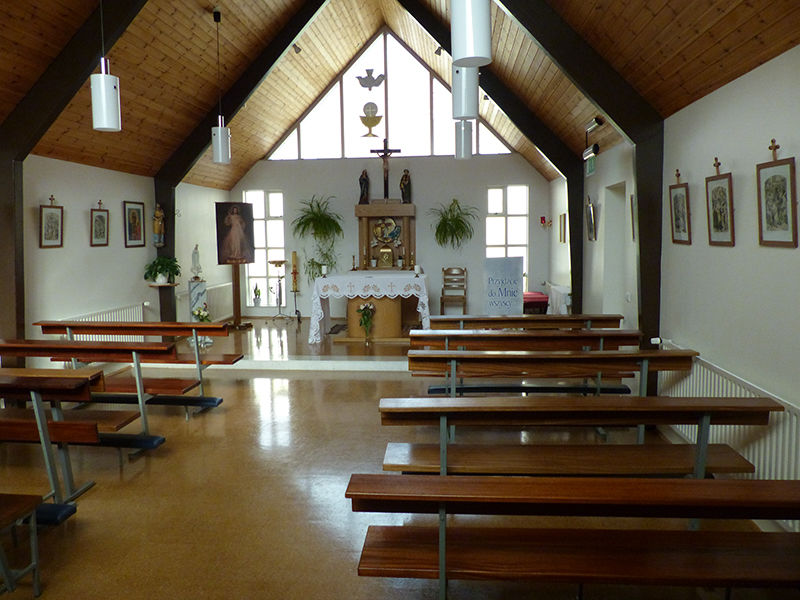Travel guru Rick Steves and I share a similar ancestry (Norwegian), age range (none of your business) and a bespectacled, blond-ish facade (God’s work, not ours). And while our bank accounts are nothing alike, we also share a passion for traveling to and writing about places both known and less well-known.
Recently, my wife and I were blessed to visit several locales in Northern Europe, only one of which Rick has featured in his long-running PBS television series. Along the way we found — by design (twice) and by happy accident (once) — Catholic parishes in a part of the world where Protestants are by far the majority faith community.
In each case, these Catholic churches are the lone parish serving its community, well removed from its closest neighbor parish, but with a strong and active parishioner base — a base that is often more immigrant (Polish, Irish, Filipino and more) than native. Following is a look at these European churches which may be found, if not through Rick Steves’ “back door,” then certainly off the beaten tourists’ path — and which happily welcome any and all visitors.
Bergen, Norway: St. Paul Church
The major port of western Norway’s and the country’s second largest city (pop. 272,000), Bergen has a proud history, having been headquarters of the old Hanseatic League of northern European merchants (fish traders, mostly) from the 14th through 18th centuries. Its Catholic history is not nearly as proud — the post-Reformation years were less than kind to Catholics — but recent decades have seen far more tolerance and acceptance of non-Protestant faith followers in a country that is 90 percent Lutheran.
St. Paul — Bergen’s sole Catholic parish, near Bergen’s easy-to-walk historic downtown sector — dates back to 1843, and now serves 12,000 parishioners and a parish school. Plans are in development to build more parishes in the area, part of the Diocese of Oslo whose Catholic population, while only 3 percent of Norway’s total, has doubled in the past decade.
Sunday Masses are celebrated in Norwegian, English and Polish, and occasionally (depending on the Sunday of the month) in Tagalog, French, Lithuanian, Vietnamese and Tamil. (Most Saturday Vigils are in Latin.)
Like churches of all faiths throughout Norway, St. Paul’s also enjoys a vibrant music ministry. “Music is important in our churches,” says Amund Dahlen, parish music director, “and important to our faith.”
St. Paul Church, Nygårdsgaten 3, 5015 Bergen, Norway; http://bergen.katolsk.no.
Lerwick, Scotland: St. Margaret and the Sacred Heart Church
Across the North Sea, some 230 miles directly west from Bergen, is Lerwick (pronounced LEHR-ick), the principal city (pop. 7,500) of Scotland’s Shetland Islands, with roots dating back 4,000 years (check out the Jarlshof ruins, less than 30 minutes from town).
Like Bergen, Lerwick’s weather is often cloudy, damp and cool, which accounts for the preponderance of woolen knitwear in shops and on bodies (of both the sheep who grow it and the humans who knit and/or buy it). And because offshore oil drilling has long been among Lerwick’s principal industries, it makes sense that this profession is represented in stained glass inside Shetland’s lone Catholic parish — the northernmost Catholic Church, in fact, in all of Great Britain.
St. Margaret and the Sacred Heart Church — a few blocks’ walk from the portside shopping district — opened in 1911 and serves a closely-knit population of 400 people, very few of them native Shetlanders. The majority are from the surrounding British Isles, the U.S., Poland, Germany, the Philippines and Malta. Its pastor, Father Anil Gonsalves, is a native of India.
The parish is within the Diocese of Aberdeen with Bishop Hugh Gilbert living “an hour’s aeroplane journey away,” said a parish representative. “Yet modern means of communications overcome problems of distance.”
St. Margaret and the Sacred Heart Church, 87 St Olaf St., Lerwick, Shetland; http://stmargaretsshetland.org.uk.
Isafjordur, Iceland: St. John the Evangelist Chapel
Just inland from the northwest coast of this island nation known for stunning beauty, geothermal power and weather befitting its “cool” name lies a village, surrounded by fjords and populated by 2,600 people who are kind, easy-going, and, if not regular churchgoers, certainly welcoming to visitors in a manner befitting any faith-filled community.
Isafjordur (Issa-fee-YOR-der) also is the home of Iceland’s newest Catholic outpost, the Chapel of St. John the Evangelist (Johannesarkapella, so new that it wasn’t on the diocesan website when we visited late last summer). The parishionership of less than 100, most of them Polish immigrants, sit on picnic bench-style pews for 11 a.m. Sunday Mass, celebrated by a priest who travels throughout the region.
Part of the Diocese of Reykjavik — seven parishes serving the entire country whose Catholic population of 3,500 is less than 4 percent of Iceland’s total — St. John’s a parochial mission of Reykjavik’s Christ the King Cathedral. (Reykjavik’s bishop, installed last fall, is David Tencer, a Capuchin Franciscan from Slovakia.)
St. John’s community — including residents from tiny fishing and farming villages nearby and not-so-nearby — is “active and enthusiastic in support of their faith,” says Father Peter Breen, diocesan vicar general and a native of Dublin. “And we are growing in number.”
St. John’s Chapel, Mjallargata 9, 400 Ísafjör√∞ur, Iceland; http://en.catholica.is.

